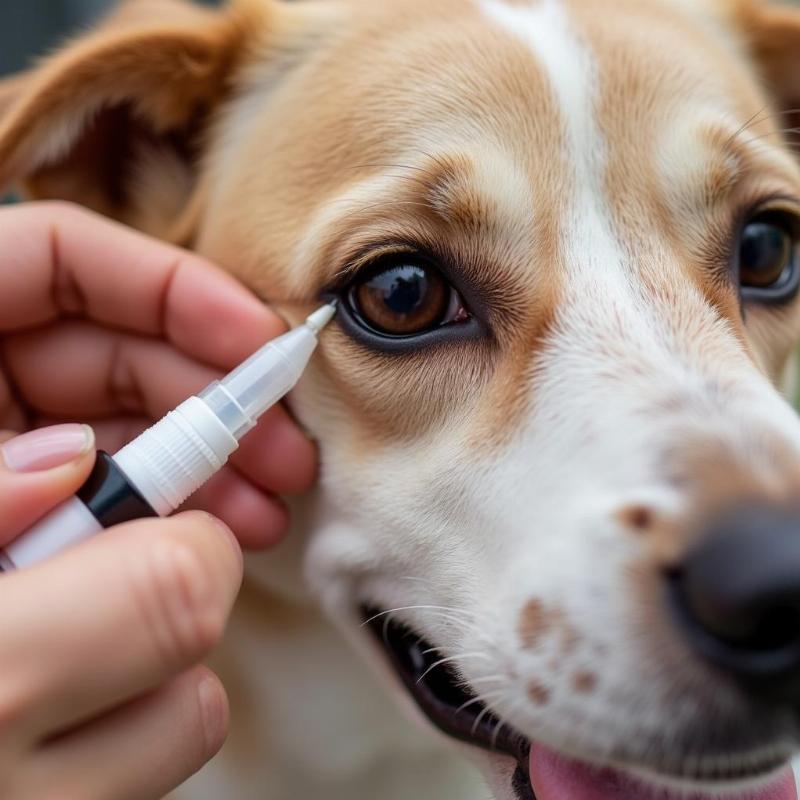Dorzolamide eye drops are commonly prescribed for dogs to manage certain eye conditions, particularly glaucoma. Understanding how these drops work, when they are necessary, and how to administer them correctly is crucial for every dog owner facing this diagnosis. This comprehensive guide will provide you with everything you need to know about dorzolamide eye drops for dogs, ensuring your furry friend receives the best possible care.
Understanding Dorzolamide and Its Uses in Dogs
Dorzolamide belongs to a class of medications called carbonic anhydrase inhibitors. These drugs work by decreasing the production of aqueous humor, the fluid that fills the eye. This, in turn, helps to lower intraocular pressure (IOP), which is essential in managing glaucoma. High IOP can cause pain and eventually lead to blindness. Besides glaucoma, dorzolamide can also be used to treat other conditions associated with elevated IOP.
 Administering Dorzolamide Eye Drops to a Dog
Administering Dorzolamide Eye Drops to a Dog
Administering Dorzolamide Eye Drops: A Step-by-Step Guide
Administering eye drops can sometimes be challenging, especially with wiggly dogs. Here’s a step-by-step guide to help you administer dorzolamide effectively:
- Wash your hands: Thoroughly wash your hands with soap and water before handling the medication.
- Position your dog: Hold your dog securely, preferably with assistance from another person.
- Gently pull down the lower eyelid: Create a small pocket between the eye and the eyelid.
- Administer the prescribed number of drops: Be careful not to touch the dropper tip to your dog’s eye or surrounding area.
- Close the eye for a few seconds: Gently close your dog’s eye for a few seconds to allow the medication to distribute evenly.
- Reward your dog: Offer a treat and praise to create a positive association with the process.
Potential Side Effects and Precautions
While generally safe, dorzolamide can have potential side effects. These can include:
- Local irritation: Redness, stinging, or tearing.
- Bitter taste: This can cause increased salivation.
- Systemic effects: In rare cases, lethargy, loss of appetite, or vomiting might occur.
When to Consult Your Veterinarian
If your dog experiences any unusual symptoms after receiving dorzolamide, contact your veterinarian immediately. It is also crucial to follow your veterinarian’s instructions carefully regarding dosage and frequency of administration. Never adjust the dosage or stop the medication without consulting your veterinarian first.
Dorzolamide and Other Medications
Inform your veterinarian about all other medications your dog is currently taking, including over-the-counter drugs and supplements. Certain medications may interact with dorzolamide.
What are the signs of glaucoma in dogs?
Common signs of glaucoma in dogs include excessive tearing, cloudiness of the eye, redness, squinting, and apparent pain.
Can dorzolamide cure glaucoma?
Dorzolamide helps manage glaucoma by lowering IOP, but it does not cure the underlying condition. It is a crucial part of long-term management to prevent further vision loss.
How long does it take for dorzolamide to work?
Dorzolamide usually begins to lower IOP within a few hours of administration. The full effect can be seen within a few days.
Conclusion
Dorzolamide eye drops are a valuable tool in managing glaucoma and other eye conditions in dogs. By understanding how these drops work and how to administer them correctly, you can help ensure your furry friend maintains optimal eye health and quality of life. Always consult your veterinarian for proper diagnosis and treatment recommendations specific to your dog’s condition. Don’t hesitate to ask questions and advocate for your pet’s wellbeing.
FAQ
- How often should I administer dorzolamide eye drops to my dog? This depends on your veterinarian’s prescription, but typically it is administered two to three times daily.
- What should I do if I miss a dose? Administer the missed dose as soon as you remember. If it is close to the next scheduled dose, skip the missed dose and resume the regular schedule.
- Can I use human dorzolamide eye drops on my dog? No, never use human medications on your dog without consulting your veterinarian.
- Are there any alternative treatments for glaucoma in dogs? Yes, there are other medications and surgical options available. Your veterinarian can discuss the best course of action based on your dog’s individual needs.
- How can I prevent glaucoma in my dog? Regular veterinary check-ups, especially for breeds predisposed to glaucoma, are essential for early detection and management.
- What are the long-term effects of glaucoma in dogs? Untreated glaucoma can lead to blindness and significant pain. Consistent treatment and monitoring are essential for managing the disease.
- Can diet affect glaucoma in dogs? While diet alone doesn’t cause glaucoma, a healthy diet contributes to overall well-being, supporting the effectiveness of any treatment.
Beautdogs.us is your premier resource for all things dog-related in the US. We offer expert advice on dog breeds, care, and the best products for your furry friend. Whether you’re a new dog owner or a seasoned pro, Beautdogs.us provides reliable information to help you navigate the world of dog ownership. Contact us today for personalized guidance and support. Email: [email protected], Phone: +1 501-555-7529. Learn more at Beautdogs.us.